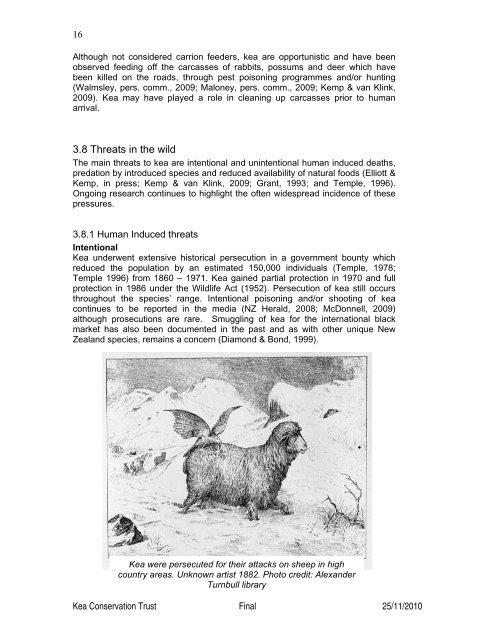(Nestor notabilis) Husbandry Manual - Kea Conservation Trust
(Nestor notabilis) Husbandry Manual - Kea Conservation Trust
(Nestor notabilis) Husbandry Manual - Kea Conservation Trust
Create successful ePaper yourself
Turn your PDF publications into a flip-book with our unique Google optimized e-Paper software.
16<br />
Although not considered carrion feeders, kea are opportunistic and have been<br />
observed feeding off the carcasses of rabbits, possums and deer which have<br />
been killed on the roads, through pest poisoning programmes and/or hunting<br />
(Walmsley, pers. comm., 2009; Maloney, pers. comm., 2009; Kemp & van Klink,<br />
2009). <strong>Kea</strong> may have played a role in cleaning up carcasses prior to human<br />
arrival.<br />
3.8 Threats in the wild<br />
The main threats to kea are intentional and unintentional human induced deaths,<br />
predation by introduced species and reduced availability of natural foods (Elliott &<br />
Kemp, in press; Kemp & van Klink, 2009; Grant, 1993; and Temple, 1996).<br />
Ongoing research continues to highlight the often widespread incidence of these<br />
pressures.<br />
3.8.1 Human Induced threats<br />
Intentional<br />
<strong>Kea</strong> underwent extensive historical persecution in a government bounty which<br />
reduced the population by an estimated 150,000 individuals (Temple, 1978;<br />
Temple 1996) from 1860 – 1971. <strong>Kea</strong> gained partial protection in 1970 and full<br />
protection in 1986 under the Wildlife Act (1952). Persecution of kea still occurs<br />
throughout the species’ range. Intentional poisoning and/or shooting of kea<br />
continues to be reported in the media (NZ Herald, 2008; McDonnell, 2009)<br />
although prosecutions are rare. Smuggling of kea for the international black<br />
market has also been documented in the past and as with other unique New<br />
Zealand species, remains a concern (Diamond & Bond, 1999).<br />
<strong>Kea</strong> were persecuted for their attacks on sheep in high<br />
country areas. Unknown artist 1882. Photo credit: Alexander<br />
Turnbull library<br />
<strong>Kea</strong> <strong>Conservation</strong> <strong>Trust</strong> Final 25/11/2010












